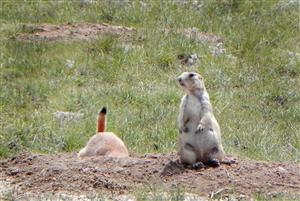The black-tailed prairie dog (Cynomys ludovicianus) inhabits the eastern third of Colorado. According to one estimate, black-tailed prairie dogs once covered seven million acres in Colorado. They typically reside in grassland areas below 6,000 feet, east of Colorado's foothills.
Currently, black-tailed prairie dog populations in Colorado are facing two main threats: sylvatic plague and habitat loss and fragmentation. Sylvatic plague is an introduced disease that can cause the near complete loss of a prairie dog colony in a matter of weeks. Habitat loss and fragmentation has led to colonies being less connected which can make recovery from plague more difficult.
Relocation Information
In Colorado, it is unlawful to capture, transport, and relocate black-tailed prairie dogs from one site to another suitable site without a permit from Colorado Parks and Wildlife.
Research and Management
Statewide survey of black-tailed prairie dog distribution & status
Since 2000, Colorado Parks and Wildlife (CPW) has monitored the status of black-tailed prairie dog populations throughout Colorado. In an effort to develop baseline information on the status of the species, the environmental consulting firm EDAW was contracted in early 2000 to collect and field verify data throughout the species range. An additional effort used fixed-winged aerial surveys of the eastern Colorado prairie in a statistically valid design to estimate distribution and relative status of black-tailed prairie dog colonies during 2006-07. Both efforts were part of an overall CPW contribution to assessing the potential classification of black-tailed prairie dogs as an endangered species.
In 2016, CPW contracted with Western EcoSystems Technology to implement the rangewide methodology that was developed in 2011. This work includes analyzing aerial imagery and validating the results with fixed-wing flights and ground-truthing. The monitoring will be repeated in 2020.
CPW's Wildlife Health Program has conducted several studies to develop and test the efficacy of tools to manage plague in Colorado’s wildlife. The use of insecticides to control fleas that vector the plague bacterium was described in the Journal of Wildlife Diseases. Insecticides and oral vaccination were also shown to prevent the plague-associated collapse of prairie dog colonies. A field manual was compiled to describe equipment and recommend techniques to monitor and manage plague in Colorado’s ecosystems. An evaluation of techniques to monitor the short-term survival of translocated prairie dogs was also conducted.
Reports
Associated Research Publications
Tripp, DW, Streich SP, Sack DA, Martin DJ, Griffin KA, Miller MW. 2016. Effects of seasonal deltamethrin application on flea and plague control in white-tailed prairie dog colonies. Journal of Wildlife Diseases. 52: 553–561. https://doi.org/10.7589/2015-10-290
Tripp, DW, Rocke TE, Runge JP, Abbot RC, Miller MW. 2017. Annual burrow dusting or oral vaccination prevents plague-associated black-tailed prairie dog colony collapse. EcoHealth. 14: 451–462
https://doi.org/10.1007/s10393-017-1236-y
Tripp, DW, Corro LM, Magstadt SR, Sack DA. 2018.
Plague Management Techniques and Monitoring in Colorado’s Prairie and Shrub-steppe Ecosystems (PDF). Colorado Parks and Wildlife Technical Publication 51.
Sack, DA and Tripp DW. 2020. A Comparison of Two Methods to Monitor Translocated Prairie Dogs. Wildlife Society Bulletin. 44:416-423.
https://doi.org/10.1002/wsb.1098

